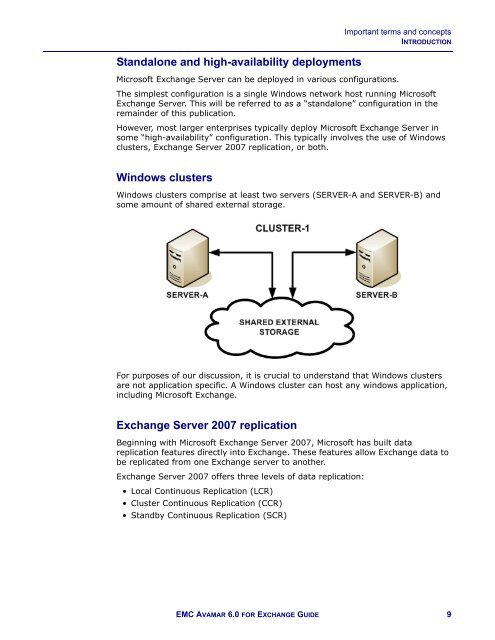EMC Avamar 6.0 for Exchange Guide - EMC Community Network
EMC Avamar 6.0 for Exchange Guide - EMC Community Network
EMC Avamar 6.0 for Exchange Guide - EMC Community Network
You also want an ePaper? Increase the reach of your titles
YUMPU automatically turns print PDFs into web optimized ePapers that Google loves.
Standalone and high-availability deploymentsImportant terms and conceptsINTRODUCTIONMicrosoft <strong>Exchange</strong> Server can be deployed in various configurations.The simplest configuration is a single Windows network host running Microsoft<strong>Exchange</strong> Server. This will be referred to as a “standalone” configuration in theremainder of this publication.However, most larger enterprises typically deploy Microsoft <strong>Exchange</strong> Server insome “high-availability” configuration. This typically involves the use of Windowsclusters, <strong>Exchange</strong> Server 2007 replication, or both.Windows clustersWindows clusters comprise at least two servers (SERVER-A and SERVER-B) andsome amount of shared external storage.For purposes of our discussion, it is crucial to understand that Windows clustersare not application specific. A Windows cluster can host any windows application,including Microsoft <strong>Exchange</strong>.<strong>Exchange</strong> Server 2007 replicationBeginning with Microsoft <strong>Exchange</strong> Server 2007, Microsoft has built datareplication features directly into <strong>Exchange</strong>. These features allow <strong>Exchange</strong> data tobe replicated from one <strong>Exchange</strong> server to another.<strong>Exchange</strong> Server 2007 offers three levels of data replication:• Local Continuous Replication (LCR)• Cluster Continuous Replication (CCR)• Standby Continuous Replication (SCR)<strong>EMC</strong> AVAMAR <strong>6.0</strong> FOR EXCHANGE GUIDE 9
















